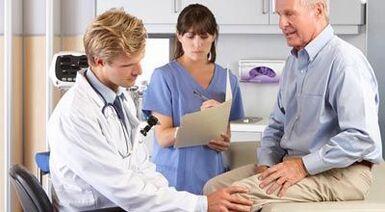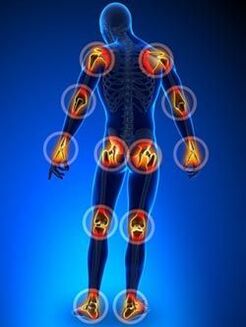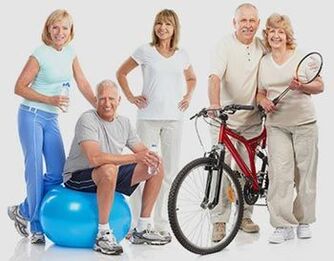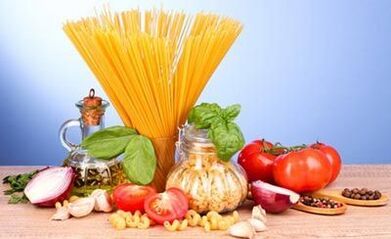Arthrosis of the joints is a complex dystrophic disease associated with the destruction of cartilage tissue within the joints.This pathological process is the most common common disease in the world.Arthrosis is manifested by pain, breakfast of breakfast and restriction of mobility.The gradual progression of the symptoms is characteristic, however, the degree of development of the disease may be different.
The diagnosis is made on the basis of an anamnesis, clinical examination and radiography results.The treatment of arthrosis is usually conservative: exercise therapy, anti -inflammatory drugs, physiotension, blockade, etc.
We will consider in more detail what this disease is and how to treat it, we will consider further in the article.
What is arthrosis?

Arthrosis is degenerative changes in the structure of the joints, which are associated with significant pain and deformation.The second name of the disease, which is used in the international classification - osteoarthrosis.
The disease is characterized by slow progression, although it can be accelerated by several external factors.It all depends on the individual characteristics of the body, the human disease and its method of vital activity.
According to statistics, arthritis is ill with 6.5-12% of the globe's population.Mostly people over 65 years old (62-85% of cases) suffer.There is a tendency to "renew" pathology: in different countries about 30-35% of patients are people aged 45-65 years, and 2-3% aged 20-45 years.
People who are little familiar with medicine think arthritis and arthritis are one and the same.In fact, this is not the case, because in the first case the disease is acute inflammatory, and in the second - a long, less pronounced chronic.

The types
The formulation of the diagnosis for arthritis may be different, although the essence of the disease is the same.Most often, questions and misunderstanding of patients relate to some terminal arthritis terms:
- Arthrosoarthritis is a classic arthrosis, in which an inflammatory process is pronounced;
- Osteoarthrosis is absolutely the same as arthrosis;
- deformation (osteoarthrosis) - late stages of felt disease, which are manifested by deformation and closure of the joint;
- Coxarthrosis - an abbreviated term indicating the hip joint lesion;
- Gonartrosis is an abbreviated term that means "knee arthritis";
- Spondylarthrosis is the arthrosis lesion of the small spine arc joints.
There are many types of this disease.Classification can occur based on the localization of the affected areas and depending on the causes of the disease.
Types of arthrosis depending on localization:
- Knees
- junction
- Cervical
- Brachial
- Hands and fingers
- Spine
- Key
- Polyosteoartrosis
Depending on the number of nodes included, the following varieties are distinguished:
- Monoarthrosis.
- Oligoarthrosis - no more than 2 nodes are affected.
- Polartrosis - included by 3 articular groups.
The degree of damage to the union
| Ladder | Symptoms |
| 1st degree | The first stage of arthrosis - no significant morphological changes, only the composition of the synovial fluid is disturbed.Worse supply to the cartilage tissue with nutrients, cartilage resistance to conventional loads decreases.Due to the overload of the articular surfaces, inflammation occurs, pain occurs. |
| 2 stairs | The knot is destroyed.Osteophytes are formed.Pain during loads and movement becomes stronger, a characteristic crisis is heard in the affected places. |
| 3 degrees | This is the most severe stage of developing this disease.There is a pathological difference in the locations of the injured joints.Inflammation occurs.The patient feels stiffness when moving, as the muscles cannot be fully contracted and fulfilled their functions. |
Reason
Arthrosis formation is facilitated by two causes - the load and the lack of a full food that supplies vitamins, minerals for tissue restoration.Each person's connections carry a load.Athletes and dancers, with physical work, the load on foot is greater, which means that bone joints wear faster and require high quality food.With a smooth lifestyle, the supporting apparatus wear more slowly but also requires periodic renovation of fabrics.
Priority
This type is often associated with innate inferiority and the tendency of cartilage over damage and destruction as a result of metabolic disorders.The most common causes that cause this disease:
- hereditary and genetic;
- menopause;
- Frequent and, at first glance, minor damage (for example, among athletes).
Arthritis
Secondary type is most often deformation of arthrosis and progresses against the background of a decrease in cartilage stability in the usual load.The development of this pathology is facilitated by:
- injuries;
- Obesity;
- weakness of ligaments and muscles;
- arthritis.
With age, predisposition to the disease increases.After 70 years, arthritis is diagnosed with every second retiree.Since the maximum load falls to the foot (a person moves - walks, stands, runs, throws), then it is here that the first signs are formed.
Signs and symptoms of arthrosis
Arthrosis belongs to the category of chronic diseases.Sometimes the disease can flow significantly for years, only occasionally remembering the pain in the joints in the joint or difficult movement.But it also happens that the disease develops rapidly at a severe stage in just a few months.
In any case, it is important to remember, if you do not treat the disease, its symptoms will increase over time, worsening the quality of life and in severe cases - leading to disability and immobilization.
Symptoms with arthrosis of the joints:
- Pain painful sensations with arthritis are pronounced, especially after different types of loads.When a person comes in a state of peace, after a while, unpleasant sensations disappear.Localization of pain appears directly in the place where changes have occurred in the usual structures of the body.In some cases, pain in arthritis can occur when a person rests, being completely calm.They appear very harsh and tightly, which can be compared to toothache.Most often this happens in the morning.
- The second sign of arthrosis is a crisis, but you should not confuse this symptom with the usual click of joints, which is found in almost every person, and does not bring discomfort.A stalemate in the disease is characterized by gross and dry sound, it results in severe pain and discomfort.With the development of the disease, the symptom is becoming more special and painful.
- Reducing joining mobility.It is also considered one of the characteristic symptoms of arthrosis, but already appears in the stage of active progression of the disease.During the development of arthrosis, the growth/germination of bone neoplasms occurs, which leads to muscle tissue spasms, reducing lumen in the common bag - restriction of movement in this country is guaranteed.
- Common deformation.Its modification is determined by the fact that osteophytes grow on the bone surface and reaches synovial fluid.Although deformation is one of the latest symptoms, when arthrosis has hit the joint to a large extent.
- Changes in muscle tone.At first, especially with severe pain, the periarticular muscles are reflexively tense.In the future, as motor activity loses, atrophy muscles.
- Skin manifestations.An optional sign.In the initial stages, rash on the joining projection is possible.In the future, while arthrosis and muscle atrophy progresses, the skin becomes pale, becomes dry, pigmented.
| Nodes that arthritis most often affects: | Less suffer: |
|
|
Complications
If arthritis does not provide proper attention, in time and not to treat properly, it can lead not only to the complete destruction of the diseased node, but also to a change in spinal biomechanics, which makes its hernias on intervertebral discs and the development of arthrosis in others, so far still begins healthy joints.
The risk of premature treatment of any type of arthritis lies in the complications associated with it, the adverse consequences:
- Inflamed connections are gradually deformed and destroyed;
- Movements become limited, joint mobility is partially or completely limited;
- The spine is disturbed;
- Hernia is formed interdisciplinary;
- Neuralgia develops;
- The standard of living of the patient with arthritis is reduced;
- The person becomes incapable.
Troubleshooting
First of all, they try to see structural changes in the affected areas, to assess their severity and spread.Also, metabolic disturbances in the body must be determined, which have become a favorable backdrop for the appearance of arthrosis.Therefore, the survey set consists of the following events:
- Radiography.
- Magnetic resonance tomography.
- Ultrasound study.
- Arthroscopy.
- Biochemical blood tests (hormonal spectrum, inflammation markers, calcium metabolism, rheumine).
Considering radiological features, experts in the field of orthopedics and traumatology distinguish the following stages of arthrosis (Kellgren-Liwrence):
- Stage 1 (suspicious arthrosis) - suspicion of narrowing the joint gap, osteophytes are missing or available in a small amount.
- Stage 2 (soft) - suspicion of narrowing the joint gap, osteophytes are clearly defined.
- Stage 3 (moderate) - a clear narrowing of the common gap, there are clearly expressed osteophytes, bone deformities are possible.
- Stage 4 (severe arthrosis) - a pronounced narrowing of the joint gap, large osteophytes, pronounced bone deformities and osteosclerosis.
Please note: the course of the disease under consideration is very slow and in the first stage may not be characterized by any symptoms, and pain contrary to joints and increased fatigue can be natural even for healthy people with great physical exercises.Therefore, independent diagnosis of arthrosis is almost impossible.
How to treat arthrosis of the joints

Principles of Arthrosis Treatment:
- eliminate excess loads on the joints;
- Therapy with anti -inflammatory and analgesic pills.Also, in complex therapy, chondroprotectors are actively used for arthritis;
- Physical education of physiotherapy;
- Sanatorium treatment;
- magnetotherapy, electrotherapy, laser therapy, shock wave therapy;
- intra -articular oxygenotherapy;
- intraosse blockade;
- It is important to choose the right food for arthritis.
Medication methods
How to treat arthrosis with medicines?This issue is more common among patients.Treatment is performed using three groups of drugs:
- Chondroprotectors.The drugs of this group reset the hyaline cartilage as they contain the ingredients that are part of it.They are recommended by all patients in the form of a long-term work (courses 3-4 months 2 times a year).Use tablets and capsules.
- Hormonal corticosteroids.This group of medicines is more effective during the period of arthrosis irritation.Most often, intramuscular injections are made.But a similar category of medicines in the pharmacy is also represented in the form of plaster, ointments - they are used only externally, you can expect a fairly rapid and powerful effect.
- The use of non -steroidal anti -inflammatory drugs in order to reduce the pain and eliminate the inflammatory process.
- Injections.Injection medicines quickly stop pain, reduce active symptoms.Intramuscular, intravenous or intra -articular administration of the drug should only be performed by one medical worker.These funds are unable to save the patient because of the development of the disease, but effectively reduce his adverse manifestations.
Other medicines for the treatment of arthrosis are used medicines:
- improving blood in the joints;
- Improving the supply of common oxygen tissue - "B" vitamins;
- acting on metabolism in the cartilage;
- desensitizing agents that reduce body reactivity;
- Synthetic adrenal gland hormones.
Surgical treatment
Surgical methods mean two ways to solve the problem:
- Arthroscopy is an operation performed in a sore joint.Through the puncture, a separate needle is introduced, which removes the damaged areas and polishes the affected area.
- Prosthetics is a complicated operation, which consists of removing damaged joints and embedding a new one.Modern orthopedics went ahead, releasing new, improved prostheses, which are rarely rejected by the body, and their wearing does not cause discomfort.
Arthritis therapy
Physical medical education is used for arthrosis in the subacute phase.Main Tasks of Exercise Therapy:
- orthopedic correction (elimination of defects of the affected limbs);
- Reduce static load on the joints;
- Improving the mobility of the joint or preventing its deterioration.
Digoen gymnastics and a series of exercises for the muscles and unresolved joints are performed.Exercises for the affected joints are performed in a lie position, on the side or on the back, sitting.They are alternating with respiratory exercises that help to relax muscles.The patient performs movement in the affected joint independently or with the help of an instructor.
During classes, the appearance of pain should not be allowed.Exercises are performed at a slow pace and only after the elimination of acute symptoms.Sudden and high movements of amplitudes should be avoided, which can provoke unpleasant sensations.
Physical education should be engaged in overseeing a doctor, and after acquiring the necessary skills, you can start exercising at home.
Physiotherapy and manual therapy
The use of these methods of treatment gives very good results in the initial stages of arthrosis.
- Manual treatment should only be performed by an experienced physician who has proven itself in the treatment of articular pathologies.For example, in the treatment of knee joint arthrosis, manual therapy along with limb extraction, intra -articular injections and intake of chondroprotectors can quickly place the patient on his feet.
- Physiotherapy is used as auxiliary treatment to accelerate the rehabilitation period.Their main purpose is to reduce inflammation and accelerate tissue regeneration.Procedures such as: laser and cryotherapy, thermal-ozokerite treatment, mud baths, paraffin therapy and UOF are widely used.
Food and diet

The diet with arthrosis of the joints is aimed at correcting metabolic processes, body weight, preventing irreversible changes in the hyaline cartilage of the joints, a decrease in the inflammatory process, and strengthening common connective tissue structures.There is no special diet with arthritis of the joints.The following principles are based on therapeutic food:
- Food should be physiologically complete and balanced with a high content of vitamins and minerals.The energy value of the diet for patients with normal weight should correspond to the average value of daily energy consumption and not exceed it.
- The use of salt is limited to 5-8 g/day, as well as salted products (salt, canned food, chips, salted fish).
- The use of free fluid should be increased to 2-2.5 l/day.
- It is necessary to exclude the processing of products using frying.Food should be baked, steamed, cook or boil.
- You need to switch to frequent, partial food.
- Food should be taken into small portions, which will exclude overeating and weight gain.
With arthrosis, it is forbidden to use a difficult extreme diet.Since in this type of diet the body expels a large amount of fluid, which, in turn, washed calcium and potassium from the bones and joints.
Useful products:
- Fish and seafood, nuts, oil oil, as a source of omega - 3.
- Low -retail meat and jelly.
- Products rich in vitamin E, D, C, A and groups B. These are fruits, vegetables and fresh berries.Especifically especially useful to use: beets, tomatoes, carrots, cabbage, blueberries, legumes, bananas, oranges, apples and whole wheat bread.
- Ginger and other spices.
- Dairy and dairy products are an excellent source of calcium.
- Beneficially squeezed juices freshly squeezed.
Prohibited products:
- Fast food, sausage products, semi -finished products, chips and all refined products.
- Fatty meat.
- Sdoba, white bread, sugar.
- Fat milk products, salted cheeses.
- Mayonnaise, transgenic fats.
- White rice, semolina.
- Marinade, conservation, salting.
- Alcohol, energy, soda.
Popular methods of treatment
Before using any popular arthritis remedies, be sure to consult your attending physician.
- Mash Nettle and Juniper berries to a homogeneous mass.Connect to the 1: 3 butter. To relieve the pain, rub the sore joints up to 3 times a day.
- Roots, flowers or branches of a black elderberry.Pour 1 tbsp.spoons of raw material with 1 cup boiling water.Insist, wrapper, 3 hours, then strain.Drink 1/4 cup to 4 times a day 30 minutes before meals.
- Boil 10 g of bay leaves in 250 ml of water for five minutes.Leave for five hours.Drink occasionally in small sips throughout the day.Three days we are treating them, we rest for five, then we are treated for three days.
- Mustard compresses honey.Mix mustard powder with honey and add an egg.Put the resulting oil in the gauze and apply to the injured site.
- Complex compresses.Cut the cabbage cut into slightly pieces and go through the liquid.Line the natural wool tissue in the juice and glue it to the injured site.
- One series is another excellent remedy for the treatment of arthrosis.Boil in 250 ml of boiling water 2 large spoons of a series.After 20 minutes, the decoction is ready.Take 2 tablespoons three times daily before meals.The course is 30 days.
- Chamomile oil, calendula and Burdock faces pain well, relieves inflammation.For its preparation, you need to mix in equal amounts of chamomile flowers, calendula, burying root, tie herb with oil jelly and leave for 1-2 days.Use oil for severe pain up to 5 times a day.
- In boiling water, place equal parts of the willow bark, birch and calendula flowers.Boil the mixture for 10 minutes, then let it create the same amount under the lid.You need to get a cooled decoction 200 ml half an hour before meals.
PREVENTION
In a decrease in the risk of arthritis, the following moments play an important role:
- Get rid of extra pounds;
- Treatment of muscular -skeletal pathologies;
- active lifelong movement;
- proper nutrition (diet, balanced diet);
- Avoiding common hypothermia;
- A healthy lifestyle with the right regimen.































